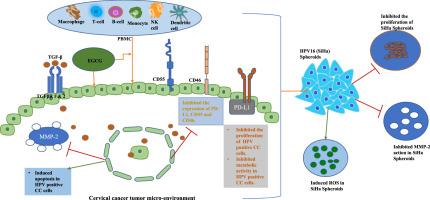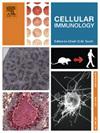EGCG remodels the TGF-β cervical cancer micro-environment towards immune responsiveness
IF 2.9
4区 医学
Q2 CELL BIOLOGY
引用次数: 0
Abstract
Background
Exploring the role of immune modulators alongside TGF-β in cervical cancer (CC) and PBMCs may improve the understanding of targeted treatment strategies.
Methods
We analyzed expression, overall survival (OS), correlation and tumor infiltration of PD-L1, CD55 and CD46, as well as immune cell fractions in CC patients using OncoDB, TIMER 2.0 and TCIA. RT-PCR and western blotting was performed to assess PD-L1, CD55 and CD46 expression. Viability, mitored, apoptosis and MMP-2 were evaluated in CC cells co-cultured with PBMCs. Morphology, crystal violet staining, ROS and MMP-2 were examined in SiHa spheroids.
Results
PD-L1 was upregulated, CD55 was significantly increased and CD46 showed no significant difference in HPV16 positive compared with HPV negative individuals. Elevated PD-L1, CD55 and CD46 were associated with reduced OS in HPV16 positive individuals. PD-L1 and CD55 showed moderate positive and negative correlation with TGF-β, respectively, whereas CD46 correlation was negligible. Immune fractions including M1 macrophages (31 %), M2 macrophages (17 %), CD8 T cells (21 %), NK cells (10 %), were linked to reduced OS. TGF-β, PD-L1 and CD46 infiltration were positively corelated with CD8+ T cells. In CC cells, TGF-β stimulation increased PD-L1, while decreasing CD55 and CD46, reducing viability, metabolic activity and inducing apoptosis in HPV (+) co-cultures. EGCG treatment under TGF-β, reduced PD-L1, CD55 and CD46 expression, decreased viability, metabolic activity and MMP-2 secretion, while inducing apoptosis in SiHa co-culture. In 3D spheroids, EGCG inhibited proliferation and MMP-2 activity while increasing ROS production.
Conclusion
EGCG, by targeting TGF-β and modulating PD-L1 and mCRPs, represents a promising candidate for immunotherapeutic development in CC.

EGCG对TGF-β宫颈癌微环境免疫应答的影响
背景探讨免疫调节剂与TGF-β在宫颈癌(CC)和PBMCs中的作用可能有助于提高对靶向治疗策略的理解。方法采用OncoDB、TIMER 2.0和TCIA分析CC患者PD-L1、CD55和CD46的表达、总生存期(OS)、相关性和肿瘤浸润情况,以及免疫细胞组分。RT-PCR和western blotting检测PD-L1、CD55和CD46的表达。对与PBMCs共培养的CC细胞进行活力、有丝分裂、凋亡和MMP-2的测定。对SiHa球体进行形态学、结晶紫染色、ROS和MMP-2检测。结果HPV16阳性个体与HPV阴性个体相比,spd - l1表达上调,CD55表达显著升高,CD46表达无显著差异。在HPV16阳性个体中,PD-L1、CD55和CD46升高与OS降低相关。PD-L1和CD55分别与TGF-β呈中度正相关和负相关,而CD46的相关性可以忽略不计。包括M1巨噬细胞(31%)、M2巨噬细胞(17%)、CD8 T细胞(21%)、NK细胞(10%)在内的免疫部分与OS降低有关。TGF-β、PD-L1、CD46浸润与CD8+ T细胞呈正相关。在CC细胞中,TGF-β刺激增加了PD-L1,同时降低了CD55和CD46,降低了HPV(+)共培养细胞的活力、代谢活性和诱导凋亡。TGF-β作用下EGCG可降低SiHa共培养细胞的PD-L1、CD55和CD46表达,降低细胞活力、代谢活性和MMP-2分泌,同时诱导细胞凋亡。在三维球体中,EGCG抑制增殖和MMP-2活性,同时增加ROS的产生。结论egcg通过靶向TGF-β,调节PD-L1和mCRPs,是一种很有前景的CC免疫治疗候选药物。
本文章由计算机程序翻译,如有差异,请以英文原文为准。
求助全文
约1分钟内获得全文
求助全文
来源期刊

Cellular immunology
生物-免疫学
CiteScore
8.20
自引率
2.30%
发文量
102
审稿时长
30 days
期刊介绍:
Cellular Immunology publishes original investigations concerned with the immunological activities of cells in experimental or clinical situations. The scope of the journal encompasses the broad area of in vitro and in vivo studies of cellular immune responses. Purely clinical descriptive studies are not considered.
Research Areas include:
• Antigen receptor sites
• Autoimmunity
• Delayed-type hypersensitivity or cellular immunity
• Immunologic deficiency states and their reconstitution
• Immunologic surveillance and tumor immunity
• Immunomodulation
• Immunotherapy
• Lymphokines and cytokines
• Nonantibody immunity
• Parasite immunology
• Resistance to intracellular microbial and viral infection
• Thymus and lymphocyte immunobiology
• Transplantation immunology
• Tumor immunity.
 求助内容:
求助内容: 应助结果提醒方式:
应助结果提醒方式:


